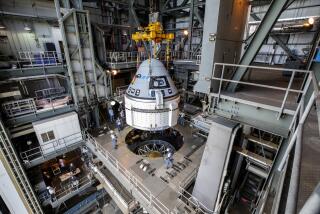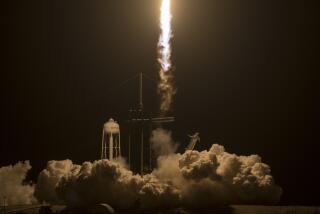Series of Problems Plagued Challenger From 1st Flight
When the Challenger was destroyed by an explosion Tuesday during the launching of what would have been its 10th mission, it was the latest and most serious of a series of problems that had plagued the vehicle. Intriguingly, all of the prior problems had involved the shuttle’s propulsion systems, which are suspected to be the cause of Tuesday’s explosion.
The first mission of the doomed space shuttle Challenger scheduled for January, 1983, was postponed for two months because of cracks in the fuel line supplying hydrogen to its motors.
The third mission of the Challenger in August, 1983, came within seconds of a disaster when the lining of the exhaust nozzle on one of its two solid rocket boosters almost burned through.
The eighth launching of the Challenger was halted at three seconds before blastoff due to a malfunction of a coolant valve in one engine. When that mission was finally launched, the orbiter limped into an irregular, low-Earth orbit when one of the three main motors shut down prematurely.
In fact, the Challenger has been the hard-luck ship in the shuttle fleet. The only other significant propulsion problem in the shuttle program occurred during the planned June 26, 1984, launching of the Discovery. That mission was aborted four seconds before liftoff when a computer discovered an anomaly in one engine. The engine was replaced and the mission, rescheduled for Aug. 30, 1984, was uneventful. There is no evidence to suggest that a recurrence of one of the problems that dogged Challenger’s previous flights was responsible for Tuesday’s explosion. Indeed, there is no hard evidence to support any speculations about the disaster.
Nonetheless, at least two of the prior incidents--if the timing had been slightly different--might have produced an explosion like Tuesday’s.
On Dec. 18, 1982, sensors reported an excess of hydrogen around engine No. 1 during a routine test firing of the engines on the launching pad. Investigation showed that the cause was a crack in the fuel line supplying the engine.
The engine was removed and replaced, but in subsequent test firings, similar cracks were found in the other two engines, and they were also replaced.
Had the crack occurred during the launching, an explosion would almost certainly have resulted.
The cracks occurred in each engine at the site where a metal sleeve had been welded onto the hydrogen line to cut down chafing that might have occurred if the line rubbed an adjacent component. The sleeves had not been used on the first shuttle, Columbia, because its motors had operated at a lower thrust and chafing was not a problem.
The first Challenger mission was subsequently flown uneventfully without the sleeves, and the problem was presumably corrected. At press time, the engine’s manufacturer, Rockwell International, would not say how the correction had been accomplished.
Mission Uneventful
Challenger’s third mission was also uneventful. When the spent solid rocket boosters were recovered from the ocean, however, technicians observed that the coating lining the exhaust nozzle of one of the boosters had come perilously close to burning through.
Flames in the exhaust nozzle reach a temperature of 5,800 degrees Fahrenheit. To protect the metal casing of the exhaust nozzle, it is lined with a three-inch layer of a heat-resistant material made of glass fibers, carbon and epoxy resin. During firing of the rocket, this lining corrodes away slowly, dissipating heat. Similar materials are used to protect spacecraft that re-enter the Earth’s atmosphere at high speed.
Normally, about half of the three-inch thickness would be burned away during the launching. On Challenger’s third mission, however, only 0.2 inch of lining remained. The then-head of the shuttle program, Lt. Gen. James A. Abrahamson, said that if the rocket had fired for only eight more seconds, the lining and the casing would have burned entirely through.
Scenario for Tragedy
Had that happened, the thrust from the rocket would have become highly erratic and the sideways thrust would have tried to make the rocket pinwheel. The orbiter might have been able to disengage itself from the booster if a hole in the exhaust nozzle had developed late in the launching sequence and if the sideways exhaust did not strike any key components of the orbiter or fuel tank.
One scenario for Tuesday’s explosion suggests that a crack or hole developed in the solid fuel of the booster and that the exhaust opened a hole in the side of the rocket. The hot exhaust might then have burned a hole in the relatively thin side of the main fuel tank or ignited the shuttle’s self-destruct system.
The premature degradation of the exhaust nozzle lining was ultimately traced to a problem in curing of the epoxy resin, which led to the unusual burning.
The key point is that the problem with the liner was not observed during any of the routine quality control procedures.
Eighth Launching Halted
On July 12, 1985, Challenger’s eighth launching was halted three seconds before liftoff when a coolant valve on engine No. 2 malfunctioned. Had the valve malfunctioned and closed during the flight, the engine could have overheated, causing an explosion.
A new engine was installed and launching occurred on July 29. During the launching, a sensor reported that engine No. 1 was overheating and the engine was shut down. Challenger continued into orbit with the remaining two engines. It was subsequently disclosed that a second engine came close to shutting down, but that it was kept running with a manual override.
Increasingly, speculation about the cause of the shuttle disaster has focused on the solid rocket boosters that help lift the orbiter into space, the main fuel tank that supplies the liquid hydrogen and liquid oxygen for the orbiter’s three rocket engines, and the rocket engines themselves.
Focus on Boosters
Late Thursday, NBC News reported that NASA was focusing its investigation on the solid rocket boosters--in particular, on the “fill joint seam.” The solid rocket boosters are received by NASA in short sections that are joined together at the Kennedy Space Center.
The fill joint seam is the point where those sections are spliced together.
The presence of flames and small explosions around the left solid rocket booster immediately preceding the catastrophic fireball that ended the mission, as well as the timing of the explosion--which occurred during the period of maximum physical stress on the vehicle--strongly suggest the possibility of mechanical failure of one of the three components of the propulsion system.
Much of the speculation about the accident in the last two days has centered on the solid rockets because of the presence of those flames. In particular, it has been noted that hydrogen leaking from the main fuel tank or the motor would have burned colorlessly.
The orange-yellow color of the observed flames suggested that the solid rocket was their source.
NBC reported that NASA engineers had begun to focus their investigation on the solid rocket booster after viewing unreleased videotapes that showed the flames from a different and more revealing angle.
More to Read
Sign up for Essential California
The most important California stories and recommendations in your inbox every morning.
You may occasionally receive promotional content from the Los Angeles Times.










